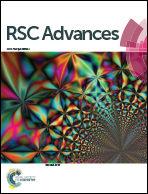Three cobalt-based coordination polymers with tripodal carboxylate and imidazole-containing ligands: syntheses, structures, properties and DFT studies†
Abstract
Three cobalt-based coordination polymers [Co(Htatb)(1,3-bimyb)] (1), [Co(Htatb)(bimbp)]·DMF (2), and [Co(Htatb)(1,4-bimyb)]·H2O (3) [H3tatb = 4,4′,4′′-s-triazine-2,4,6-tribenzoic acid, 1,3-bimyb = 1,3-bis(imidazole-1-ylmethyl)benzene, bimbp = 4,4′-bis(imidazolyl)biphenyl, 1,4-bimyb = 1,4-bis (imidazole-1-ylmethyl)benzene] were synthesized by hydrothermal reactions and characterized by single-crystal X-ray diffraction, thermogravimetric analyses, IR spectroscopy, UV-vis spectroscopy and elemental analysis. Compound 1 shows a double-strand chain structure, due to the intermolecular O–H⋯O hydrogen bonds and aromatic π–π stacking interactions, the adjacent chains are connected to produce a 3D supramolecular structure. Compound 2 shows a 2D structure with a 1D channel. Compound 3 displays a 2D layer structure, furthermore these layers are joined by O–H⋯O hydrogen bonding to generate a four-fold interpenetrating 3D architecture. The fluorescence properties of 1–3 and the magnetic behavior of 1 and 2 have also been investigated. Based on their crystal structures, compounds 1 and 2 were investigated using hybrid DFT methods at the B3LYP/6-31G (d) level. The DFT-BS approach was applied to study the magnetic coupling behavior. The results reveal that the calculated exchange coupling constants J were in good agreement with the experimental data.



 Please wait while we load your content...
Please wait while we load your content...